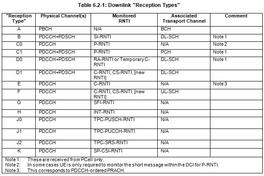LTE RNTI vs. GUTI: Identifiers Explained
Advertisement
RNTI stands for Radio Network Temporary Identifier, and GUTI stands for Globally Unique Temporary UE Identity. This article explains the basics of RNTI identifiers and GUTI within the LTE (Long-Term Evolution) system.
LTE RNTI Types
Here’s an overview of various LTE RNTI identifiers, including P-RNTI, SI-RNTI, RA-RNTI, Temporary C-RNTI, C-RNTI, SPS C-RNTI, TPC-PUSCH-RNTI, and TPC-PUCCH-RNTI.
| RNTI Identifier Type | Function | Range | Logical Channel | Transport Channel |
|---|---|---|---|---|
| P-RNTI | Paging | FFFE | PCCH | PCH |
| SI-RNTI | Broadcast of System Information | FFFF | BCCH | DL-SCH |
| RA-RNTI | Random Access Response | 0001 to 003C | - | DL-SCH |
| Temporary C-RNTI | Contention Resolution when no C-RNTI is available | 0001 to FFF3 | CCCH | DL-SCH |
| Initial layer-3 message transmission | CCCH, DCCH,DTCH | UL-SCH | ||
| C-RNTI | Dynamically scheduled unicast transmission | DCCH, DTCH | UL-SCH, DL-SCH | |
| Triggering PDCCH ordered random access | - | - | ||
| SPS C-RNTI | Semi-persistent scheduled unicast transmission (activation, reactivation, retransmission) | UL-SCH,DL-SCH | UL-SCH, DL-SCH | |
| Semi-persistent scheduled unicast transmission (deactivation) | - | - | ||
| TPC-PUSCH-RNTI | Uplink Power Control | - | - | |
| TPC-PUCCH-RNTI | Uplink Power Control | - | - |
RNTIs are applicable within the RAN (Radio Access Network). All RNTIs have the same length: 16 bits.
- P-RNTI: Used during the paging procedure. The UE starts decoding a paging message after finding a DCI (Downlink Control Information) whose CRC (Cyclic Redundancy Check) bits have been scrambled by the P-RNTI.
- SI-RNTI (System Information RNTI): Used during the acquisition phase of System Information Blocks (SIBs). The UE decodes system information after finding a DCI whose CRC has been scrambled by the SI-RNTI.
- RA-RNTI (Random Access RNTI): Used during the random access procedure. DCI formats 1A and 1C with CRC bits scrambled by RA-RNTI allocate PDSCH (Physical Downlink Shared Channel) resources to random access response messages.
- Temporary Cell RNTI (C-RNTI): Allocated to the LTE UE within the random access response message. It’s used for contention resolution when a C-RNTI isn’t yet available. For example, when sending an RRC (Radio Resource Control) connection request on CCCH (Common Control Channel) for initial access.
LTE GUTI
GUTI is used to provide a temporary identity that is globally unique. An LTE GUTI has the following three components:
- PLMN Identity: Uniquely identifies the network globally.
- MME Identity (MMEI): Uniquely identifies the MME (Mobility Management Entity) within the PLMN.
- MME-TMSI (M-TMSI): Uniquely identifies the UE within the MME.
 Image: LTE GUTI structure
Image: LTE GUTI structure
The PLMN identity is generated using MCC (Mobile Country Code) and MNC (Mobile Network Code). The MCC is 3 digits (decimal), and the MNC is either 2 or 3 digits (decimal). Each digit is coded using 4 bits BCD (Binary-Coded Decimal).
The MMEI is derived from the MME Group ID (MMEGI) and MME Code (MMEC). The MMEGI is unique within the PLMN, while the MMEC is unique within the MME Group.
The Globally Unique MME Identifier (GUMMEI) is generated from the MCC, MNC, and also the MMEI.
Advertisement
 RF
RF


